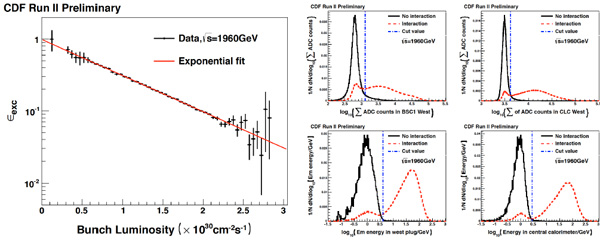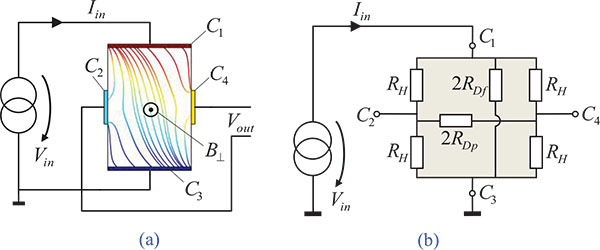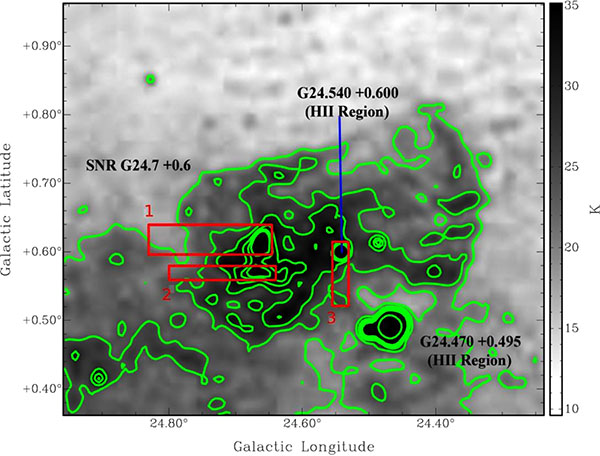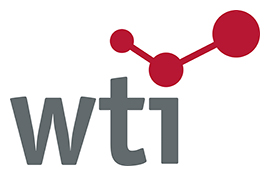RESEARCH ARTICLE
Diffraction at CDF
Konstantin Goulianos*, §
Article Information
Identifiers and Pagination:
Year: 2014Volume: 1
Issue: Suppl 1: M12
First Page: 75
Last Page: 78
Publisher Id: PHY-1-75
DOI: 10.2174/1874843001401010075
Article History:
Received Date: 25/11/2013Revision Received Date: 24/1/2014
Acceptance Date: 25/1/2014
Electronic publication date: 31/12/2014
Collection year: 2014
open-access license: This is an open access article licensed under the terms of the Creative Commons Attribution Non-Commercial License (http://creativecommons.org/licenses/by-nc/3.0/) which permits unrestricted, non-commercial use, distribution and reproduction in any medium, provided the work is properly cited.
Abstract
We present results on central exclusive production of π+π- in collisions at and 1960 GeV using events with two charged hadrons in the final state within the pseudorapidity region |η |≤ 1.3 and no particles in |η| > 1.3. These results open a new window into hadron spectroscopy, and may be used as benchmarks for testing relevant theoretical models.
PACS Number(s): 13.30.Eg.
1. INTRODUCTION
The CDF Collaboration (CDF) has been studying diffraction in collisions for the past quarter century, aiming to understand the QCD aspects of the diffractive exchange, a strongly interacting color-singlet quark/gluon combination with vacuum quantum numbers, traditionally referred to as Pomeron (IP) exchange. 1 Such exchanges lead to large, non-exponentially suppressed pseudorapidity regions devoid of particles, called rapidity 2 gaps. Diffractive processes are classified as single dissociation or single diffraction, SD, characterized by a forward gap adjacent to a surviving , or p double dissociation or double diffraction, DD, characterized by a central gap, and central diffraction or double-Pomeron exchange (CD or DPE), a process with two forward gaps.
A special class of diffraction is central exclusive production, a DPE process in which a specific state is centrally produced [3]. CDF has published results on exclusive dijet (2008) [4], µ+;µ- (ZcJ/Ψ and J/Ψ, and (2009)[5] , and γγ / e+e− and /(2012) [6] production In this paper, we report on the observation of exclusive π+π/- production [7] and compare our results with theoretical expectations.
2. CENTRAL EXCLUSIVE PRODUCTION OF π+π-
2.1. Detector, Triggers, Datasets
Detector. The CDF II detector is shown schematically in Fig (1). It consists of the main detector, labeled CDF II in this figure, equipped with a tracking system and calorimeters (central: CCAL, plug: PCAL), and the forward components (Cherenkov Luminosity Counters: CLC, MiniPlugs: MP, Roman Pot Spectrometer: RPS). The RPS and MP were not active in this study, and from the BSC only those covering the pseudorapidity region of are used.
Triggers. The following two triggeres were used for data collection:
- signal: two CCAL towers (|η |< 1.3) with energy E > GeV (a very low threshold!) and no energy in BSC (|η |= 5.4 − 5.9) and in the Forward Plug Calorimeters (|η |= 2.11− 3.64)
- zero-bias: offline selected bunch-crossing events with no tracks, for use in noise/exclusivity studies.
Datasets. The signal datasets consist of 90(22) ˟1010 events at GeV.
 |
Fig. (1). Schematic plan view of the CDF II detector showing the tracking system and calorimeters (CCAL, PCAL), and forward components (MP, CLC, BSC, RPS); the BSC are electrostatic beam separators. |
2.2. Preliminary Results
We report results for events with exactly two tracks within rapidity and where there is useful acceptance at all pt. No particle ID is (yet) being used, and the observed tracks are assumed to be due to pions.
We select events in regions of instantaneous luminosity 1˟1030 <L< 2.2 ˟1030 cm–2s–2 (Fig. 2-left), and set detector thresholds for optimum signal/noise ratio (Fig. 2-right).
Fig. (3) shows mass distributions π+π- of candidate events uncorrected (left) and corrected (right) for acceptance. The f0 (980), f2 (1270), and (1370)f0 are clearly visible. The small but significant peak at 3.1 GeV is understood to be from j/ψ→ e+e- with e+e- treated as. M π+π- The integrated cross section over the region 0<π+π-<5 GeV and at GeV [900 GeV] is 1910 ± 4 (stat.) ± 380 (syst.) [825 ±11(stat) ±s160 (syst)] nb. The higher cross section at GeV may be due to the ηmax = 5.9 same cut at both energies, while the proton beam rapidity is , allowing higher Mπ+π/- values at 1960 GeV.
 |
Fig. (3). Mπ+π/- distributions at s =1960 GeV not corrected (left) and corrected (right) for acceptance. |
Fig. (4) shows the ratio Mπ+π/- of candidates at GeV (top), and the mean pt for GeV (bottom-left) and GeV (bottom-right) Mπ+π−vs . The statistically more significant data at GeV show structures at 1.5 GeV, 2.25 GeV, and between 3 GeV and 4 GeV. Work is in progress to understand these structures, including a phase-shift analysis.
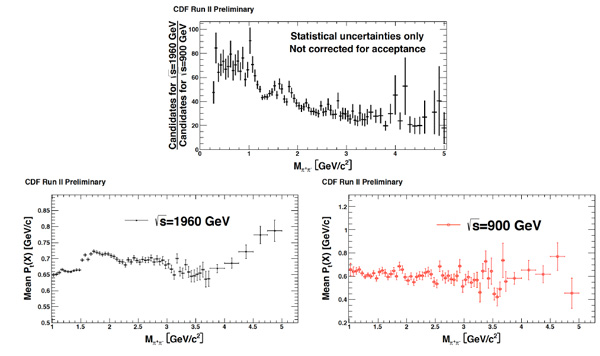 |
Fig. (4). Ratio of events at s =1960 / 900 GeV (top), and mean pt of π+π/- (left/right) vs MMπ+π−. |
In Fig. (5), we compare the distributions of dσ/ d Mπ+π− events at and 900 GeV for M π+π− < 5 GeV (left), and zoom into the region of M π+π− < 2 GeV (right) for an expanded view. At GeV, we observe features in the mass spectrum which are not yet understood and are the subject of further ongoing studies.
 |
Fig. (5). Differential cross sections dσ/ d Mπ+π− vs M π+π− at s =1960 and 900 GeV for π+π− < 5 Mπ+π− < 1.5 GeV (left) and Mπ+π- < 2 GeV (right). |
3. SUMMARY
We have measured exclusive π+π− production in collisions at GeV and GeV with the CDF II detector at the Fermilab Tevatron Collider. Using tracks, assumed to be from pions, which are the dominant charged-pair component, we explored the low mass region of π+π− < 5 GeV. We observe the well known resonances f0 (980) and f2 (1270), and see a small but significant peak at 3.1 GeV understood to be from j/ψ→ e+e- with M e+e- assumed as M π+π- We also observe features at M π+π- > 1.5 GeV, which are not yet understood. Further investigations of these features, including a partial wave analysis, are currently underway.
CONFLICT OF INTEREST
The author confirms that this article content has no conflict of interest.
NOTES
1Recent CDF results on diffraction have been presented in DIFFRACTION 2012 [1]; in the present paper we concentrate on exclusive π+π- production, closely following the CDF presentation in EDS-2013 [1].
2Rapidity,
and pseudorapidity, η = −lntan /θ2, where θ is the polar angle of a particle w.r.t. the proton beam (), are approximately equal for particles detected in the calorimeters.
ACKNOWLEDGEMENTS
I would like to thank my colleagues at the CDF Collaboration who made this work possible, and the Office of Science of the Department of Energy for financial support.


